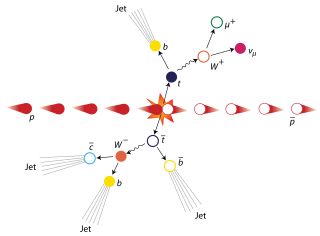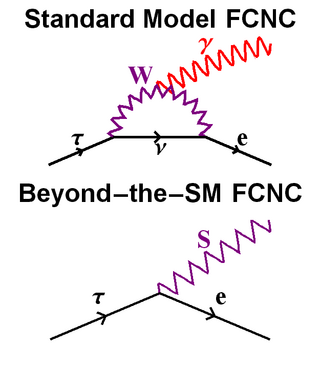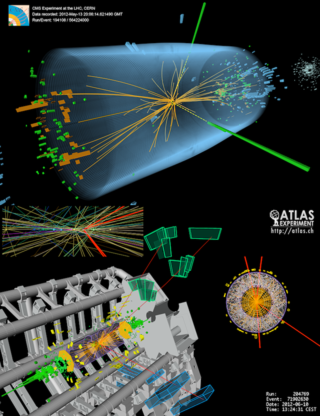Related Research Articles

The Standard Model of particle physics is the theory describing three of the four known fundamental forces in the universe and classifying all known elementary particles. It was developed in stages throughout the latter half of the 20th century, through the work of many scientists worldwide, with the current formulation being finalized in the mid-1970s upon experimental confirmation of the existence of quarks. Since then, proof of the top quark (1995), the tau neutrino (2000), and the Higgs boson (2012) have added further credence to the Standard Model. In addition, the Standard Model has predicted various properties of weak neutral currents and the W and Z bosons with great accuracy.

In particle physics, a lepton is an elementary particle of half-integer spin that does not undergo strong interactions. Two main classes of leptons exist: charged leptons, including the electron, muon, and tauon, and neutral leptons, better known as neutrinos. Charged leptons can combine with other particles to form various composite particles such as atoms and positronium, while neutrinos rarely interact with anything, and are consequently rarely observed. The best known of all leptons is the electron.

The Tevatron was a circular particle accelerator in the United States, at the Fermi National Accelerator Laboratory, east of Batavia, Illinois, and was the highest energy particle collider until the Large Hadron Collider (LHC) of the European Organization for Nuclear Research (CERN) was built near Geneva, Switzerland. The Tevatron was a synchrotron that accelerated protons and antiprotons in a 6.28 km (3.90 mi) circumference ring to energies of up to 1 TeV, hence its name. The Tevatron was completed in 1983 at a cost of $120 million and significant upgrade investments were made during its active years of 1983–2011.

The charm quark, charmed quark, or c quark is an elementary particle found in composite subatomic particles called hadrons such as the J/psi meson and the charmed baryons created in particle accelerator collisions. Several bosons, including the W and Z bosons and the Higgs boson, can decay into charm quarks. All charm quarks carry charm, a quantum number. This second generation particle is the third-most-massive quark with a mass of 1.27±0.02 GeV/c2 as measured in 2022 and a charge of +2/3 e.

The top quark, sometimes also referred to as the truth quark, is the most massive of all observed elementary particles. It derives its mass from its coupling to the Higgs Boson. This coupling is very close to unity; in the Standard Model of particle physics, it is the largest (strongest) coupling at the scale of the weak interactions and above. The top quark was discovered in 1995 by the CDF and DØ experiments at Fermilab.
In particle physics, the W and Z bosons are vector bosons that are together known as the weak bosons or more generally as the intermediate vector bosons. These elementary particles mediate the weak interaction; the respective symbols are
W+
,
W−
, and
Z0
. The
W±
bosons have either a positive or negative electric charge of 1 elementary charge and are each other's antiparticles. The
Z0
boson is electrically neutral and is its own antiparticle. The three particles each have a spin of 1. The
W±
bosons have a magnetic moment, but the
Z0
has none. All three of these particles are very short-lived, with a half-life of about 3×10−25 s. Their experimental discovery was pivotal in establishing what is now called the Standard Model of particle physics.

The Large Electron–Positron Collider (LEP) was one of the largest particle accelerators ever constructed. It was built at CERN, a multi-national centre for research in nuclear and particle physics near Geneva, Switzerland.

In particle physics, flavor-changing neutral currents or flavour-changing neutral currents (FCNCs) are hypothetical interactions that change the flavor of a fermion without altering its electric charge.

The DØ experiment was a worldwide collaboration of scientists conducting research on the fundamental nature of matter. DØ was one of two major experiments located at the Tevatron Collider at Fermilab in Batavia, Illinois. The Tevatron was the world's highest-energy accelerator from 1983 until 2009, when its energy was surpassed by the Large Hadron Collider. The DØ experiment stopped taking data in 2011, when the Tevatron shut down, but data analysis is still ongoing. The DØ detector is preserved in Fermilab's DØ Assembly Building as part of a historical exhibit for public tours.
CLEO was a general purpose particle detector at the Cornell Electron Storage Ring (CESR), and the name of the collaboration of physicists who operated the detector. The name CLEO is not an acronym; it is short for Cleopatra and was chosen to go with CESR. CESR was a particle accelerator designed to collide electrons and positrons at a center-of-mass energy of approximately 10 GeV. The energy of the accelerator was chosen before the first three bottom quark Upsilon resonances were discovered between 9.4 GeV and 10.4 GeV in 1977. The fourth Υ resonance, the Υ(4S), was slightly above the threshold for, and therefore ideal for the study of, B meson production.
The Xi baryons or cascade particles are a family of subatomic hadron particles which have the symbol Ξ and may have an electric charge of +2 e, +1 e, 0, or −1 e, where e is the elementary charge.

The Higgs boson, sometimes called the Higgs particle, is an elementary particle in the Standard Model of particle physics produced by the quantum excitation of the Higgs field, one of the fields in particle physics theory. In the Standard Model, the Higgs particle is a massive scalar boson with zero spin, even (positive) parity, no electric charge, and no colour charge that couples to mass. It is also very unstable, decaying into other particles almost immediately upon generation.

The search for the Higgs boson was a 40-year effort by physicists to prove the existence or non-existence of the Higgs boson, first theorised in the 1960s. The Higgs boson was the last unobserved fundamental particle in the Standard Model of particle physics, and its discovery was described as being the "ultimate verification" of the Standard Model. In March 2013, the Higgs boson was officially confirmed to exist.
Stuart Jay Freedman was an American physicist, known for his experiment testing Bell's inequality proposed to him by John Clauser at the University of California, Berkeley as well as for his contributions to nuclear and particle physics, particularly weak interaction physics. He was a graduate of Berkeley, receiving a Bachelor of Science in 1965 and his PhD in physics in 1972 under Eugene Commins. While at Berkeley, he worked with fellow graduate student Steven Chu. He was also recipient of 2007 Tom W. Bonner Prize in Nuclear Physics.

Luigi Di Lella is an Italian experimental particle physicist. He has been a staff member at CERN for over 40 years, and has played an important role in major experiments at CERN such as CAST and UA2. From 1986 to 1990 he acted as spokesperson for the UA2 Collaboration, which, together with the UA1 Collaboration, discovered the W and Z bosons in 1983.

]
Tulika Bose is a professor of physics at the University of Wisconsin-Madison, whose research focuses on developing triggers for experimental searches of new phenomena in high energy physics. Bose is a leader within the Compact Muon Solenoid (CMS) experiment, a CERN collaboration famous for its experimental observation of the Higgs boson in 2012.

Bradley Cox is an American physicist, academic and researcher. He is a Professor of Physics and the founder of the High Energy Physics Group at the University of Virginia.

Kétévi Adiklè Assamagan is an African American engineer and physicist at the Brookhaven National Laboratory. He was elected a Fellow of the American Physical Society in 2021. Assamagan founded the African School of Physics.
David M. Strom is an experimental high energy particle physicist on the faculty of the University of Oregon.
References
- 1 2 3 4 5 "Philip Michael Tuts Faculty Profile". Columbia University Physics Department. Retrieved 26 January 2015.
- 1 2 3 4 "Michael Tuts". World Leaders Forum. Retrieved 26 January 2015.
- ↑ Tuts, Michael. "USLUO Statement" (PDF). USLUO. Archived from the original (PDF) on 28 January 2015. Retrieved 26 January 2015.
- ↑ "Columbia University". United States at the Large Hadron Collider. Retrieved 26 January 2015.
- ↑ Freeman, David. "Scientists Raise Doubts About Higgs Boson Discovery, Say It Could Be Another Particle". Huffington Post. Retrieved 26 January 2015.
- ↑ Craig, David. "Mike Tuts is among 20 Columbia physicists chasing God's particle". Columbia Magazine. Retrieved 26 January 2015.
- 1 2 Raymond, Joan (July 13, 2009). "I'm a Particle Physicist. Want to Chat?". New York Times. Retrieved 26 January 2015.
- ↑ Tuts, Michael. "Blog of Michael Tuts". Huffington Post. Retrieved 26 January 2015.
- ↑ Than, Ker (July 4, 2012). ""God Particle" Found? "Historic Milestone" From Higgs Boson Hunters". National Geographic. Archived from the original on July 5, 2012. Retrieved 26 January 2015.